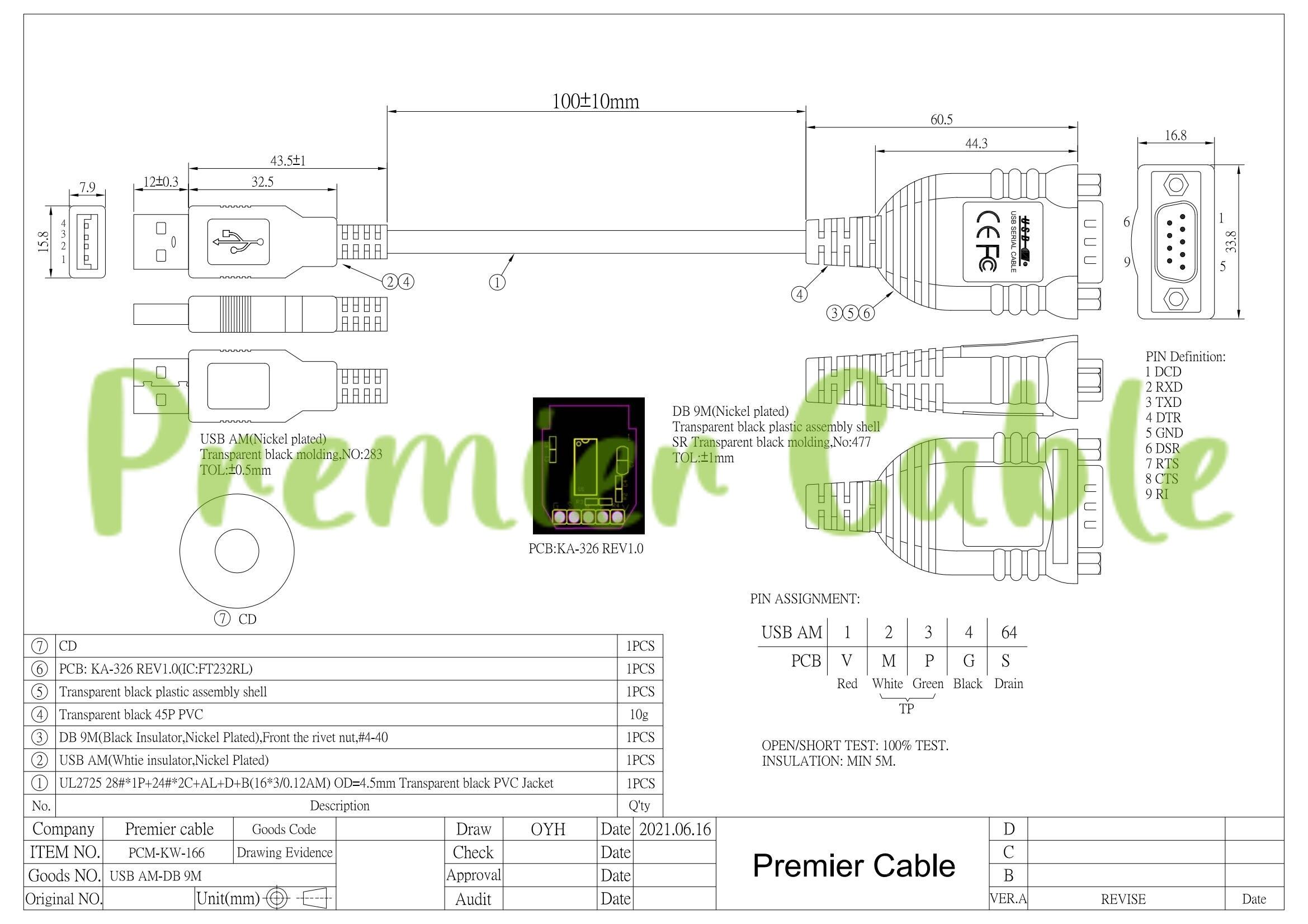Description
Introduction:
The USB to DB9 RS232 Converter Cable is a flexible serial device that enables the connection of RS232 serial devices to modern systems via a USB Type-A port. It features a USB-A interface for computer connection on one end and a DB9 male connector for older RS232 serial equipment connection on the other. It is compatible with FTDI UC232R-10 (USB to RS232 Serial Adapter with a Length of 10 cm), offering plug-and-play functionality with various operating systems without requiring additional drivers. Premier Cable P/N: PCM-KW-166
Specification:
| Type |
USB to RS232 485 422 Converter |
| Product Name |
FTDI UC232R-10 USB to DB9 RS232 Converter Cable |
| Drawing Number |
PCM-KW-166 |
| Connector A |
USB-A Male |
| Connector B |
DB9 9 Pin Male; Front the Rivet Nut, 4#-40 |
| IC |
FT232RL |
| Cable Specification |
UL2725 28#*1P+24#*2C+AL+D+B(16*3/0.12AM); OD:4.5mm; Transparent Black PVC Jacket |
| Pinout (DB9 Male) |
DCD, RXD, TXD, DTR, GND, DSR, RTS, CTS, RI |
| Cable Length |
10cm |
| Input & Output Signal |
USB Digital Signal; RS232 Serial Signal |
Features:
- FTDI Chip: The USB to RS232 Converter Cable uses a high-quality FT232RL chip in the DB9 connector for stable and efficient serial communication.
- Plug-and-Play: It supports plug-and-play functionality because there are built-in drivers that are automatically recognized and installed by most operating systems ( such as Windows, macOS, and Linux) in the original FTDI FT232RL chip.
- Power Supply: The USB RS232 Serial Cable allows the serial device to get the required power from the computer or other devices via a USB port, eliminating the need for an external power adapter.
Common Issues when using the USB to DB9 RS232 Converter Cable?
When using the USB to DB9 RS232 Serial Converter Cable, several common issues may occur. Here are some typical problems and possible solutions for your reference:
1. Driver Installation:
- Problem: The cable may not function properly if the correct drivers are not installed or are outdated.
- Solution: Please install the correct drivers according to the operating system version or try reinstalling the drivers or updating them from the manufacturer's website.
2. COM Port Recognition:
- Problem: The computer does not recognize the COM port assigned to the RS232 serial device.
- Solution: Pls check the Device Manager to verify if the port is properly recognized or try reconnecting the cable or restarting the computer.
3. Baud Rate Mismatch:
- Problem: Data transmission problems due to a mismatch in baud rates between the RS232 device and the computer.
- Solution: Please ensure the baud rates set on both devices match for proper communication by adjusting the baud rate settings in the software or device configurations.
4. Cable Connection:
- Problem: The USB or DB9 connectors may be loosely connected, causing intermittent data transfer or no communication errors.
- Solution: Pls check the cable connections for a secure matching by trying to use a different USB port on the computer or a different USB cable if available.
5. Power Supply:
- Problem: Some USB to RS232 converters may require more power than the USB port provides, leading to malfunction.
- Solution: Pls ensure that the RS232 device can receive adequate power. In addition to the converter cable, you may also need to add the additional power adapters.
6. Compatibility:
- Problem: The USB to RS232 Serial Converter Cable might not be compatible with certain versions of operating systems.
- Solution: Pls update the operating systems in time, ensuring that drivers and hardware work correctly.
Drawing:

